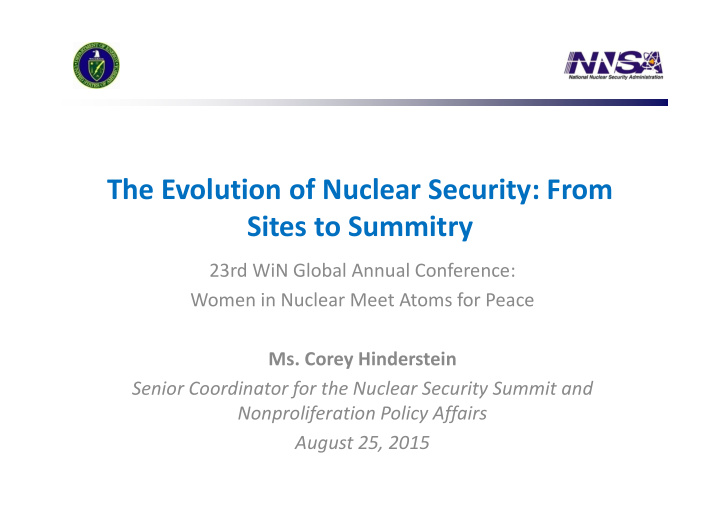



The Evolution of Nuclear Security: From Sites to Summitry 23rd WiN Global Annual Conference: Women in Nuclear Meet Atoms for Peace Ms. Corey Hinderstein Senior Coordinator for the Nuclear Security Summit and Nonproliferation Policy Affairs August 25, 2015
Mandatory Disclaimer Views are my own, and do not necessarily reflect the • National Nuclear Security Administration or the Department of Energy 2
A Trip in the Way Back Machine • Old-Fashioned views about nuclear security • Backseat to safety by operators and regulators • Little attention of senior management or Boards of Directors • Different from plant/critical infrastructure/industrial security • Domain of the “wave techs” • Engineers vs. Law Enforcement/Military attitudes • Resource burden placed by regulators, if even that • Undermining of productivity, operational efficiency and profits • Security department was the place to put the person with a bad back, a bad attitude, or both. 3
Not so long ago… • Conventional wisdom about nuclear terrorism • Mass casualties are counter to political goals of terrorist groups • A terrorist group could never build a nuclear weapon • Material is self protecting • What changed? 4
Nuclear Security Summits “So today I am announcing a new international effort to secure all vulnerable nuclear material around the world within four years...And we should start by having a Global Summit on Nuclear Security that the United States will host within the next year.” 5
2010 Washington Nuclear Security Summit • 50 world leaders, 3 international organizations “House gifts” and other national commitments – over 90% • completed by 2012 Summit • Outcomes -- material removed or eliminated, treaties ratified and implemented (CPPNM/A), reactors converted, regulations strengthened, “Centers of Excellence” launched 6
2012 Seoul Nuclear Security Summit • 53 Countries and 3 IOs More than 100 national • commitments • 13 “gift baskets” pushing beyond the consensus boundaries of the Communique 7
2014 Hague Nuclear Security Summit • 53 countries, 4 IOs Tangible Outcomes: • • Announced removals of HEU and Pu • Security at sites and on borders is increasing The global nuclear security architecture continues to be strengthened • • Radioactive source security enhanced 35 countries pledged to implement stronger nuclear security practices • • Baby steps on military materials and non-accumulation of separated plutonium. • Radiological terrorism exercise 8
Looking Ahead to 2016 • March 30-April 1 in Washington, DC • Focus on sustainability through the global nuclear security architecture. • IAEA, UN, INTERPOL, GICNT and GP • Communique 9
Since 2010…so far • > 2.5 metric tons of vulnerable HEU and plutonium material have been removed or disposed of • Seven countries – Austria, Czech Republic, Hungary, Mexico, Serbia, Ukraine, and Vietnam – have become HEU-free* • Physical security upgrades have been completed at 32 buildings storing weapons-usable fissile materials • Radiation detection equipment has been installed at 250 international border crossings, airports, and seaports to combat illicit trafficking in nuclear materials 10
Back Where We Started – Security Begins at the Site • No matter what the Presidents and Prime Ministers say at a the NSS, the material is in the custody of facilities, in the control of individuals • “Security Culture” is vital for implementation and sustainability • Demonstrable competence should be a principle at all levels of security management • Everyone has a role to play, no matter where you sit 11
THANK YOU Comments or Questions? Corey.Hinderstein@nnsa.doe.gov 12
Recommend
More recommend